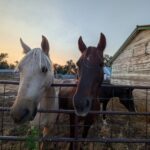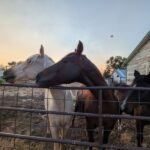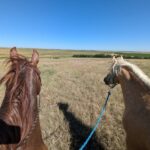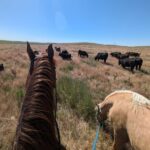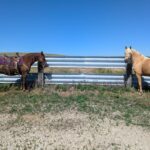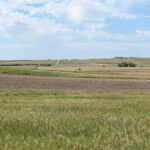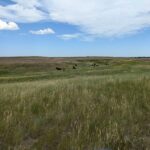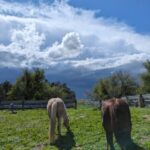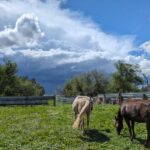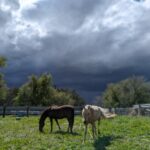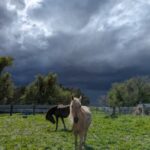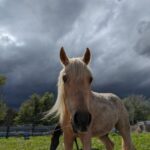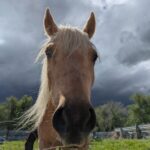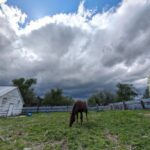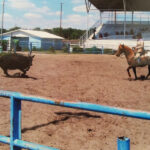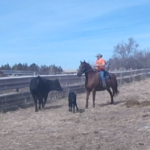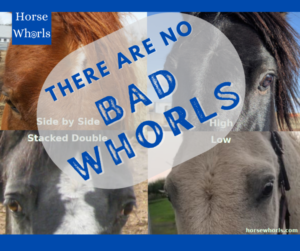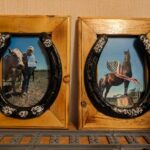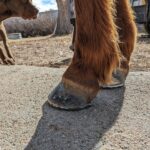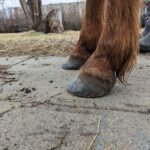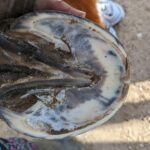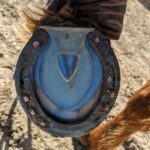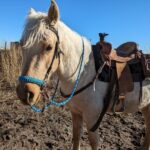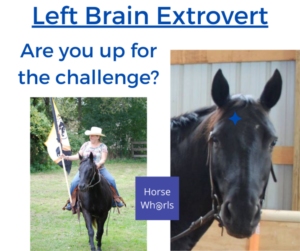Cooler Weather?
After extolling the virtues of a good Japanese bred 4wheeler I was determined to exercise my horses. It was early still, the weather not dreadfully hot. The ride wasn’t long, except for my out of shape horses. It would be good for them. Although, on my way out to catch horses, it was pretty hard not to just jump on a 4wheeler that would be faster and didn’t require saddling.
Then the horses nickered softly from their pen, calling for love and attention. Horses it would be then.
Saddling Rusty brought sweat dripping down my forehead. Here at the buildings, behind the shelter of the windbreak, there was not a drop of breeze and the cool morning was feeling pretty dang hot.
Sunshine was coming along too for the experience. As I lead them both to the first of many gates that needed rearranged Sunshine walked quietly along behind me as Rusty drug me along to the gate. Then my dog jumped out of the back of my pickup. Sunshine tucked his butt and bolted. I stepped away from Rusty trying to get out of his way. He was already going out around me that way and I nearly stepped into his path. He worked hard to avoid me and barely brushed my shoulder as be zipped past. Rusty was confused. Sunshine hit the end of the lead and stopped.
We all took a deep breath and carried on.
Out in the long narrow lane, tree lined on one side and always terrifying to horses, I was mounted and we were off. Until there was a rush of wings from the trees next to us. I dropped Sunshine’s lead. We would catch him again. I needed to get Rusty stopped. He was off too this time.
Sunshine didn’t go far, then turned and came back to us. Rusty was still hyped and wanting to take off by I managed to go back and look closer at what I had caught a glimpse of earlier. Sure enough, there was an owl hung up by a leg, hanging upside down and flopping wildly. We have a pair of owls who I am very fond of, even if they are the most likely culprits in the disappearance of my favorite barn cat. Now here one of them was stuck in a tree. The other had gone and left her as they spooked my horses.
Who does one call to rescue an owl? I thought about firemen being called to get cats out of trees? I could call the sheriff. Maybe they would know who to get a hold of at game and parks? Pondering the logistics there I managed to dismount so I could look closer. Once I was already off my spooking, shying horse, the owl must have twisted just right and the leg came free. She took off to join her mate.
I figured it would be easier to walk to the next gate.
Once we finally made it to the pasture the horses were crazed. Flies were bothering them. Sunshine was excited by the wide open. Rusty was grouchy about ponying and obnoxious youngster. It was tons of fun. We made it to the corner of the pasture without major mishap.
Then they saw the cows.
Ears up, head held high on full alert, their bodies held so tense they vibrated. I thought maybe this would be it. Eventually they settled and we were able to walk to the cows. Who decided they really didn’t feel like moving. We had to push each one. A few steps forward, then on to the next one. They aren’t at all scared. That’s the problem with having a bunch of tame heifers out with the milk cows. They see no reason to move and think maybe they should come visit for cookies and scratches instead. Sunshine thought at first they were going to eat him.
Once we got them moving a little he realized they were fun to chase and got into the game. Which upset Rusty even worse. He was ready to bolt. Head high, reins tight, pacing and fighting to go. Yay.
We made some big slow circles out behind the herd and he calmed enough to get the job done.
The bunch finally got to the corrals and I tied the horses up to wait. Sorting would be easier done on foot the way those two were acting.
With the last of the heifers separated from the steer I was after, there was a huge splash at the tank. One of the extra calves on the milk cow had gotten knocked in? Decided to go swimming? Either way, she got dunked. With much splashing and commotion she came up on the other side of the fence in one of the pens. Now I needed to get the steer out of the way so I could get her through and back with the herd. The morning had no end to the fun and surprises to offer.
Somehow the horses and I made it home, with the steer even. It was with a huge sigh of relief that I turned them back out to their pasture. They were happy and wanted to play some more. I was wondering why I would ever think horses might be better than 4wheelers. Mostly, we just need to do this more often.
4wheelers Or Horses?
There’s a lot of friendly debate, mostly friendly, in the farming and ranching worlds as to whether horses are better or 4wheelers when it comes to working cows. Of course we all know horses are better. But, the humble 4wheeler has its place.
After spending the last two miserable hot days out all day working cows and building fence, I’ve come up with the best reason of all why 4wheelers are better, in some circumstances.
The cows were out. Not badly out, not on the road or into the neighbors. Just across the electric fence into grass I was saving for them for later. It was mid 90s. I thought briefly about saddling Rusty and taking him to put them back. Then I thought about the heat and loaded my trusty green mount of Japanese breeding and loaded her in the trailer instead. She panted? maybe she was well lathered if we’re comparing her to a horse. But she gave all she had. The fan running almost constantly and the heat of the engine coming up through the seat as we put the cows back. I let her sit in the shade under a tree and cool whenever I could.
When we got to the tank I tripped the float and drank the cool fresh water straight out of the ground. Soaked my hat and as much of me as I could without getting jeans wet. Even hot is better than wet jeans. Then turned to her and asked what it is a 4wheeler would like to feel better in this heat? If you were my horse I’d soak you down, help you cool off better. She sat, silent. I figured horses and 4wheelers can’t be completely different. Dipped water out of the tank with my cap and soaked her down a bit. Water sizzling as it hit the hot engine.
The cows were back where they belonged, but wouldn’t be staying now that they had discovered the lush grass next door. So it was back the next day to get a new pasture ready for them.
The morning was still cool as we made a quick lap turning on water and checking fence. She zipped along in the morning cool. Carrying my fence stretcher, barbwire, and tools with less difficulty than a horse would. We finished that job then went for the cows as the day warmed up.
She fit under the electric fence that a few of the cows had gone through again. I could goose the throttle a little standing next to her holding the fence up and she went off to the other side where she waited patiently for me to come get her. Then she happily went back again, allowing me to chase cattle on each side of the fence without going up to the gate. Crossing the freshly worked summer fallow she struggled a little in the deep footing. I switched on 4 wheel drive and she felt better. The dust bothered her less than it did me. She didn’t get tired fighting her way through it and had more to give still as the herd balled up at the gate.
With them finally moved I left her standing quietly, waiting patiently, while we went off to lunch.
After lunch the day had reached its full potential. Easily reaching the predicted mid to upper 90 degrees, surpassing that even to reach the low 100s. The seat burnt me through my jeans when I remounted. There were a couple jobs left to do. My fencing pliers burnt my hands as I built the last gate to finish the fencing projects of the day. My pulse beat heavily in me head. The water jug was back in the pickup. She sat quietly. Her only protest the heat of the seat when I got done and wanted to go back.
One more cow moving project and we would be done.
Even after working hard in the heat all day my trusty green mount was fresh and willing. The cows not so much. There was no way to explain that I was taking them to fresh pasture. All they knew was that it was hot and they didn’t want to leave their water tank. It was a hard push. Slowly insisting one cow move at a time. At least we were pushing on grass, not freshly worked dirt. The dust wasn’t awful.
The cows finally got to the gate. The leader perked up and trotted through on her own. The rest followed enthusiastically. They quickly spread down the draw, munching on the fresh selection of grass as they explored the new area. The sight of my cows, happy and content, made the whole day worth it. Yes, we could have waited for a cooler day, but this was when they decided to cause trouble. Cows don’t always wait for more opportune moments. Sometimes they demand things be done when they are ready, not when we are ready.
It’s for these times that a 4wheeler has the most to offer. The times when the work would be so hot and miserable for a horse. A 4wheeler gives us the option to not put a horse through the hot, long, dusty days. Not that those days aren’t important to the development of a really good horse. But, within reason and with out reaching a point of outright cruelty. So, I will be thankful for my trusty green mount and the work she puts in. Then on cool mornings like today, I will go saddle my horse and get less arduous jobs done.
Horse Time
It’s been weeks since I got to do anything with my horses. That final push to get calves worked and fences up so they could go to pasture combined with the frantic rush of activity that accompanies the end of the school year took up every available drop of time and energy.
Today after spending the morning taking care of the few cows remaining here, tagging my daughters new calf, feeding everyone, and working in the garden, I was determined to get in some horse time. The sun was out, briefly, between rain showers and I thought for sure I could get just a few minutes in.
So of course the horses were on the farthest side of the pen. They happily, slowly, meandered up when I called them. So I left the gate open as I got toys ready in the pen. They followed me in, and went to grazing. In all the time since I last worked them in there the weeds had filled in nicely. The green was more then they could resist, or be drawn away from.
So they ate. I got some pretty pictures before the storm rolled in. Maybe tomorrow we can play.
Ridin’ Fence
Rusty got put to a different type of work today. He’s been complaining about baby calves. They move too slow. He really could get there faster if we just left them behind.
Strangely enough, he complained about this job too. You might almost think he doesn’t want to do anything but tricks.
I needed to check some fence. It would be faster and easier to take a 4wheeler. But, Rusty is under vet’s orders to get exercise. So I saddled him up, threw fence pliers and some staples in a saddle bag, and off we went. It was a beautiful day. The wind wasn’t blowing too bad yet. It was too hot or too cold. Just nice. The fence was in mostly good shape, just had to get off to put a few staples in. There were a few places where the wire was twisted. If he would just stand still next to it I could untwist it without getting off.
If he would just stand still next to it.
He wouldn’t. That was really too much to ask. He pawed, he pranced, he circled, anything but holding still. So we practiced standing still. He needs so much more of this. 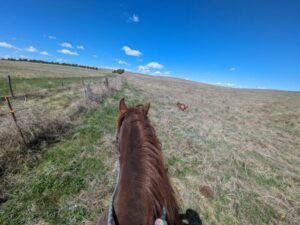
Working Horses
If You’re Going To Be Weird…
I hear Morgan people complaining a lot about how quarter horse judges wont even look at them in open shows. It’s all because they aren’t riding the right breed!
I’ve also watched a lot of Morgan people trying to show horses with very subpar training against the Quarter Horses.
Let me tell you, it’s not the breed.
I understand, the horse feels great, to you. There are also a lot of Quarter Horses out there showing with very subpar training. The difference is that we are riding Morgans. We are weird. If you’re going to be weird, you have to be good. People will probably see a few thousand Quarter Horses in their lifetime. If they see a few, or a lot, that aren’t doing a good job they’ll think back to the ones they’ve seen that did do good and dismiss the poor quality ones as a fluke.
People may see one or two Morgans in their lifetime, showing in the western divisions outside of breed shows that is. If that one is bad, they will count all Morgans as not being any good!
We are weird. It isn’t a bad thing. Our breed is wonderful. We need to step up and show the world how wonderful they are, instead of complaining about breed bias.
I’ve seen people out there madly galloping young horses in a circle, head cranked around to the center, outside shoulder heading off into the distance. This isn’t the sort of training that is going to accomplish anything in the show ring. Even if it is a first canter, if that’s how it goes, maybe the horse wasn’t ready to canter. If you lack the proper facilities to help your horse work well, go slower. Get that foundation better to you can build good form instead of teaching bad habits.
I see people working cows on a tight rein with the horse’s nose in the air, head cranked around with over enthusiastic and ineffective neck reining. That might get the job done, eventually, if you are out trying to move cattle. I’ve seen a lot of ranch horses who ride that way and spend their lives working cattle. But it isn’t going to get the job done smoothly or effectively and it sure isn’t going to get any points in the show ring.
It isn’t the judges.It’s the horse, the rider, and the training.
I have a shelf full of buckles and awards won in cow horse classes on not only a Morgan, but a gaited Morgan. She showed how very possible it is. We didn’t show hugely, but we did beat all the very good local Quarter Horses.
Go get some lesson, in person, watching videos, whatever is possible for you. Take every opportunity to learn more. Lessons are a wonderful thing. Everyone needs lessons. No matter how good you are, you need lessons. Olympic level riders take lessons. There is always room to improve. If we’re going to be weird, we have to be good. Quit hiding behind it being a breed thing and go get better! That isn’t a bad thing, it sure isn’t an insult. Taking responsibility is freeing. It gives you the opportunity to fix the problem, instead of it being out of your hands because it’s someone else’s fault.
There Are No Bad Whorls
Cows, And A Few Horses
It’s been busy with cows lately. Getting them moved and sorted and general stuff done getting ready to ship calves and start calving. Unfortunately the work has been mostly done on foot or fourwheeler.
Rusty came up foot sore after the cold spell in early January. I didn’t work with him while it was cold, because it was cold! Then with his feet hurting again he continued to be out of work. The farrier came and put some shoes on him. Hopefully the shoes will help keep him from stretching those toes out and prevent further damage. Rusty has found yet another way to be difficult by enjoying bouts of winter laminates. That means he founders in a dry lot, on grass hay, in the middle of winter 🙄
It’s been awhile since he;s done this and his feet were getting to be in really good shape. So of course he had to go and ruin that.
Sunshine has been getting big and pretty. Starting to look like a grown up, so I’ve been spending the time with him instead. Working on getting him ready to ride, maybe this summer.
I got the best Christmas gift and have been meaning to say something about it ever since. Just haven’t quite gotten to it.
A dear friend of mine in CA sent me two framed photos. One of Harvey, who we lost a year ago, and one of me and Ghost with our Guinness World Record plaque. The frames were beautiful, hand made, and thoughtful. As much as I loved them, they still couldn’t hold a candle to the note she sent with them. That meant more to me than anything else could. There are so many truly great people out there. Social media gets it’s fair share of rightfully deserved complaints. It can also do a world of good. It’s all in how you use it. I love getting to know wonderful people, people I will only ever meet online. Does that somehow lessen out relationships? I don’t believe it in any way does. Without all this ‘evil’ social media I would never get to know people like her and I am grateful.
That note was one of the best Christmas presents I’ve ever gotten.
